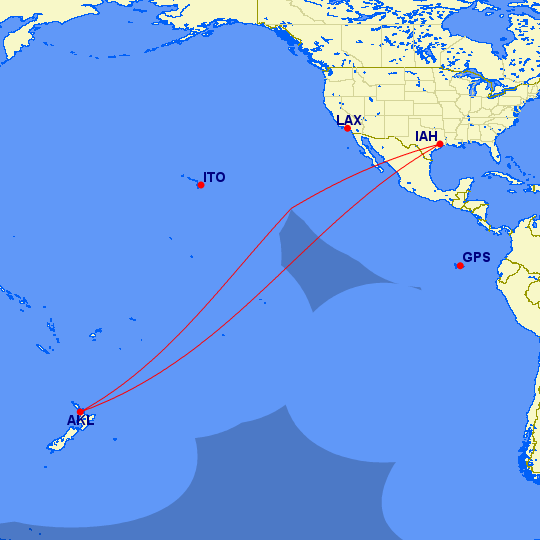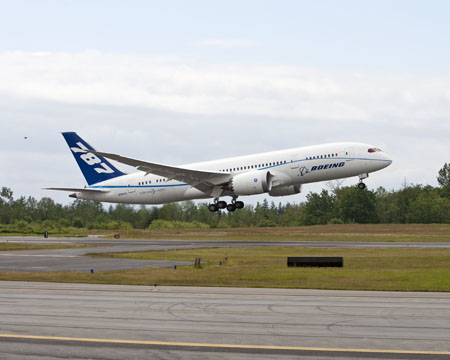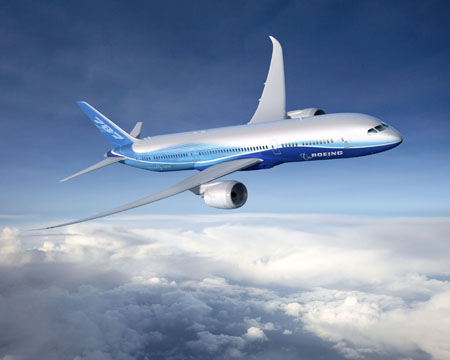If ever there was a route that the 787 was designed for, this is it.
Nearly a decade after Boeing and Airbus diverged on their respective point-to-point or hub-to-hub strategies, the first route announced for the new composite jetliner is the embodiment of the 787's business case for the new jetliner.
Continental Airlines announced on May 26 that it will
launch service with its first 787 (Airplane 49) from its Houston hub to Auckland, New Zealand 7,400 (statute) miles away in November 2011. The route will be the longest from Continental's Houston hub. For the sake of technical simplicity, let's convert 7,400mi to 6,430nm.
Connecting two distant cities with just 228 seats, a relatively modest number compared to United's 374-seat 747-400 and Continental's 276-seat 777-200ER, is what the 787 was
designed for. The leg between Houston and Auckland is now the third US route to New Zealand. The first two are currently operated by Air New Zealand (777/747) and Qantas (A330) from San Francisco and Los Angeles. Significant network and operating efficiencies are found in "eliminating" a leg from Houston to LAX or SFO.
Additionally, the planned link up of United and Continental is expected to bolster the new route with "the additional traffic flows through Houston that are expected to result from the merger." United nor Continental has said
which colors its first 787 would arrive in at the time of first delivery next August, as the timing of merger is dependent on government approval.
While Houston-Auckland is the first 787 route is the first to be announced, it will not be the first operated. If Boeing's current delivery plan holds, the 787 will enter commercial service from Haneda Airport in Tokyo on a yet-to-be-named domestic route following
first delivery of ZA100 later this year. ANA continues to keep its cards close to its vest for its early 787 routes and has not yet announced how it will configure its first. As of first flight in December 2009, ANA
had not decided on either.
Airlines such as RAM, JAL, Air India, China Southern, Ethiopian and Qatar Airways will also
introduce 787s in 2011.
For those watching the 787 program closely, the 6,430nm route prompted an immediate question: "Can the 787 fly that far with its added weight?"
The answer is YES.

At its recent Innovation Days briefings in the UK, Airbus, not known for its glowing technical assessment of the 787,
touted the early 787's range at 6,990nm with 246 passengers aboard. At that payload, Houston to Auckland is well within the reach of Continental's first 787 with 36 business class and 192 economy seats.
Boeing says the range of the 787-8 lies between 7,650 and 8,200nm. Airplanes 7 and 20 are the earliest weight saving blockpoint changes with further enhancements planned for introduction with Airplanes 34 and 50.
While the direct great-circle route from Houston to Auckland comes in at 6,430nm, the route is operated within the bounds of ETOPS requirements across the Pacific. The ETOPS goal for 787 certification is 330-minutes, with a
minimum of 207-minutes as a back up. At 207-minutes, the
track across the Pacific is roughly 80nm longer than at 330-minutes as the route takes the aircraft closer to Hilo in Hawaii.
For those airplane geeks among us (you're in good company), by the end of next year, you'll be able to get from Houston to Auckland on the A380 or the 787. With a 777-200LR leg (EK212) with Emirates to Houston from Dubai, followed by an
A380 flight (EK412) to Auckland with a stop in Sydney.








 Boeing
Boeing